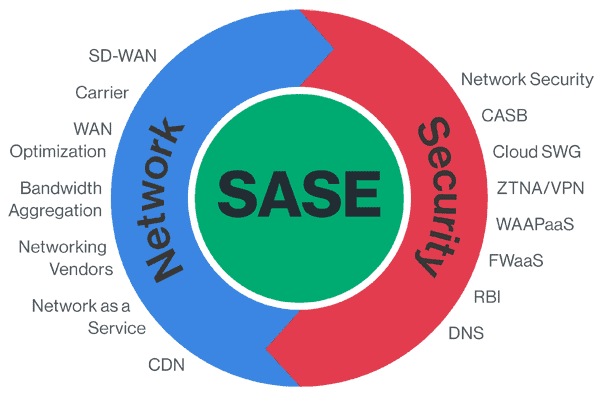What Is SASE, And Why Is It Important?

SASE is a new network architecture that merges SD-WAN (Software-Defined Wide Area Networking) to form a single, unified cloud service.
The cloud and the pressing need to secure data across the network and safety are changing dramatically. These forces require a new type of IT infrastructure, in which the network and security form a single cloud platform and a single provider service. This is the concept behind secure access service borders (SASE). This is Gartner’s latest SD-WAN solution framework. While SD-WAN is a network-as-a-service, SASE is a network-as-a-service security system.
Why is SASE Essential?
Business networks increasingly rely on cloud-based apps to run their enterprises and support distributed workflows to support remote users. This has significantly resulted in a large enterprise network emerging and significantly growing beyond the conventional network edge. This has challenged the infrastructure leaders to expand the ever-expanding attack surface.
In comparison, most networks have advanced rapidly such that they can support the workflows of these workflows in mobile or remote endpoints. Most security tools haven’t kept pace, rendering VPN-only solutions obsolete. For businesses to remain competitive, all the endpoints should be secured and managed with the same networking and security policies as their on-premise infrastructure, regardless of where they are located.
Benefits of SASE
Cost Reduction
With SASE, organizations eliminate many vendors from the disjointed model of physical and virtual equipment. They can use a single, cloud-based solution instead. Organizations can deliver more technologies and services by one provider rather than two or more, reducing the costs of miscellaneous devices and the unnecessary network complexity. SASE facilitates, for example, ongoing upgrades, patches, and network maintenance, thus further reducing costs.
Reducing the network complexity will also mean reducing IT personnel’s workload. SASE reduces IT personnel expenses while providing continuous coverage for the monitoring and reaction of network performance and security threats.
Easy management
One of the significant advantages of SASE is the ease of management. Since SASE is a single central cloud management application, it controls the entire service from one point. For instance, managing SD-WAN, NGFW, SWG, and VPN devices across several office locations within a business network needs more IT experts since more sites will be added.
However, the complexity of SASE management does not grow with the network, as it is a single cloud-based management application. It, therefore, controls the entire service, and the IT department does not have to take the time for cumbersome maintenance tasks such as replacement patches and hardware.
WAN Scalability
SASE does the same for WSN architecture what AWS, Azure, and Digital ocean did for application delivery. It allows hyper-scalability and elasticity within the WAN infrastructure. The old point-to-point solutions require much time and resources in order to scale up and down. On the other hand, SASE solutions reduce the IT load and streamline provisional times.
With cloud-based SASE solutions, IT can acquire a site in a very short time rather than several days as with the traditional WAN. Besides, the less physical hardware means minimal maintenance downtime and fewer additional software licenses. Having such enhanced efficiencies, the IT can assign staff to more sensitive tasks such as security and network monitoring.
Simplified Security Model
Legacy network solutions eventually need additional security devices and systems to meet the latest safety requirements and standards. These traditional solutions often do not provide the latest security features such as IPS, NGFW, and SWG. Companies use more security solutions to fill this gap, which only adds to the problem.
SASE removes this problem with the use of FWaaS, which integrates security features such as URL filters, IPS, malware, and firewall into its infrastructure. The delivery of FWaaS as part of the SASE solution allows businesses to manage network security, establish uniform policies, identify irregularities, and change quickly. All borders, from physical sites to mobile cloud sites, are protected in the same way.
Holistic Security
Legacy remote access devices often fail to deliver IPS, NGFW, and SWG security functions. Companies often end up with additional security points to fill the gap, but this approach does not lead to genuinely holistic safety and visibility. For example, point solutions are optimized inherently to secure a single location that makes mobile and BYOD a challenge. Similarly, numerous cloud platforms require different network visibility security solutions.
SASE addresses this problem by building security mechanisms, including URL filtering, malware control, IPS, and firewall in the network infrastructure underlying it. This means that all edges, from sites to mobile to the cloud, are protected to the same level.
Consistent data protection
Companies collect, process, and distribute huge quantities of data today. This collection includes all confidential, customer, and sensitive intellectual property information. Data Loss Prevention is the practice of protecting this sensitive data from loss. Enterprises must protect data from loss, robbery, or abuse, regardless of where data is stored.
SASE allows DLP delivery via the cloud and data centers themselves. DLP is an embedded solution within the existing control points of the company. It essentially eradicates the need for the acquisition and maintenance of multiple protection instruments.
SASE solution automates a number of DLP processes, including sensitive data discovery and classification whether stored, in use, or in-transit. SASE DLP also authenticates users and devices and controls who have access to information and applications.
SASE DLP enables you to implement protective policies across your entire network, although this covers more than one cloud environment, several applications, mobile devices, and an on-site datacenter.
A Secure Cloud Data Access
The Cloud Access Security Broker (CASB) is a security solution that addresses the challenge of keeping safe access to and for data stored while managing the cloud workload.
SASE and CASB work together with overall network security services to deliver cloud security.
Together, they address the cloud-based architecture of the WAN security requirements of a company.
Company IT ensures a proper level of visibility, data security, threat protection, and compliance for the cloud, mobile, and on-site segments of its entire network.
Like other hot buzzwords, most marketers will look to slap the term SASE to any solution that provides various SASE benefits. However, this SASE isn’t about a subset of features that are achieved by several point solutions.
Rather, it’s about a single converged platform. Its convergence and ease to use are what triggered the industry experts such as Gartner excited in the first place, and it’s what true the solution should provide.






